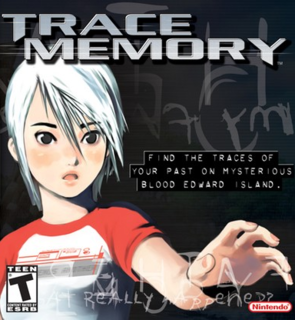This is a game that is best purchased from the inevitable bargain bins.
Another Code casts the player as young, white-haired protagonist Ashley, whose frail appearance causes her to come across looking like a trendy version of Ico’s Yorda. The game starts with Ashley travelling via boat to Blood Edward Island to meet her father, who was previously presumed dead, after receiving a mysterious package the day before her 14th birthday. Upon arriving at the island, Ashley’s father is ominously absent, and after Ashley’s aunt, Jessica, fails to return from searching for him, it’s up to Ashley to solve the dilemma. Along the way, she enters an abandoned mansion on the island and discovers there is far more to the situation than she bargained for. She must then undertake the task of piecing together all the missing parts of the puzzle that is before her.
The game can be played, for the most part, with the d-pad and buttons or by guiding Ashley with the stylus, with the latter feeling more smooth and fluid. The game’s display spreads itself across the two screens nicely. The touch screen displays a top-down, real time image of Ashley and her surroundings, while the top screen displays a pre-rendered view of areas that are of interest to Ashley. As the pre-rendered image changes, Ashley can choose to look at the contents of the frame, and the rendered view is displayed on the touch screen. This is where the game takes a cue from Myst, as the player must click on anything that looks of interest to examine it. Ultimately, the game dissolves into its rather basic core, where a player simply guides Ashley around the environment looking for new rendered screens to appear, followed by clicking on anything that looks important. However, because the important items are often ridiculously small and obscure, while many of the objects are pointless, it often leads to a tedious experience of trial and error.
Another annoying trait with the game is the fact that despite Ashley’s apparently bottomless inventory, you can only pick up an item once you have found a purpose for it. So while you know that the angel with the drum is obviously going to be important later on, you can’t pick it up until you find its exact use. This can lead to a bunch of pointless backtracking, which becomes quite tiresome towards the end of the game. However, using the items you find in puzzles is often creative and a fine use of the DS’ abilities without being gimmicky. The puzzles start of basic at first, simply rearranging pieces of a broken sign or typing in a key-code - nothing that couldn’t be done on a conventional console. However, later on, players will find themselves blowing into the microphone to clear dust of a picture or using the stylus to throw objects into the top screen. Some of the more complex puzzles are almost aggravatingly obscure and it’s likely many players will only uncover the solution by fluke.
The linear nature of Another Code is probably its most puzzling aspect - no pun intended. The story is the major driving force of events, meaning players will progress through the mansion only after they have uncovered certain parts of the story. Yet because some of the puzzles to uncover the story are so obscure, the game can grind to a standstill at points. Even more strange is the fact that the subplot appears to be both a driving force and entirely optional. Unveiling this part of the story often revolves around finding hidden items in bookcases and such, and it is possible to finish the game without ever resolving this part of the story, which seems a major focus for a large chunk of the game. However, the most frustrating aspect about Another Code’s linearity is the game’s length. Clocking in at about 5 hours, the game is disappointingly short. 5 hours wouldn’t be a problem if the game was worth replaying after completion, but due to the linear nature of the gameplay and story, it isn’t. Players will probably only wish to play again if they didn’t conclude the subplot, or if they wish to try the remixed mode, which seems to only have trivial features, such as replacing birds with ninjas.
Another Code really does have a lot going for it, and it’s a game that really wants you to like it. The graphics and design are impressive, the characters are generally charismatic, and the use of the DS’ unique features is excellent. The sound effects are sparse and the music can begin to grate after a while, but Another Code is generally a very polished package. Unfortunately, the linear nature of the gameplay and story, coupled with the game’s length, means that it doesn’t really live up to its hype or potential. It’s certainly refreshing to see this type of game today and had it been longer, it would be easier to recommend. Unfortunately, it just isn’t worth the asking price. Unless you have the ability to rent DS games or you have a large disposable income, this is a game that is best purchased from the inevitable bargain bins.

